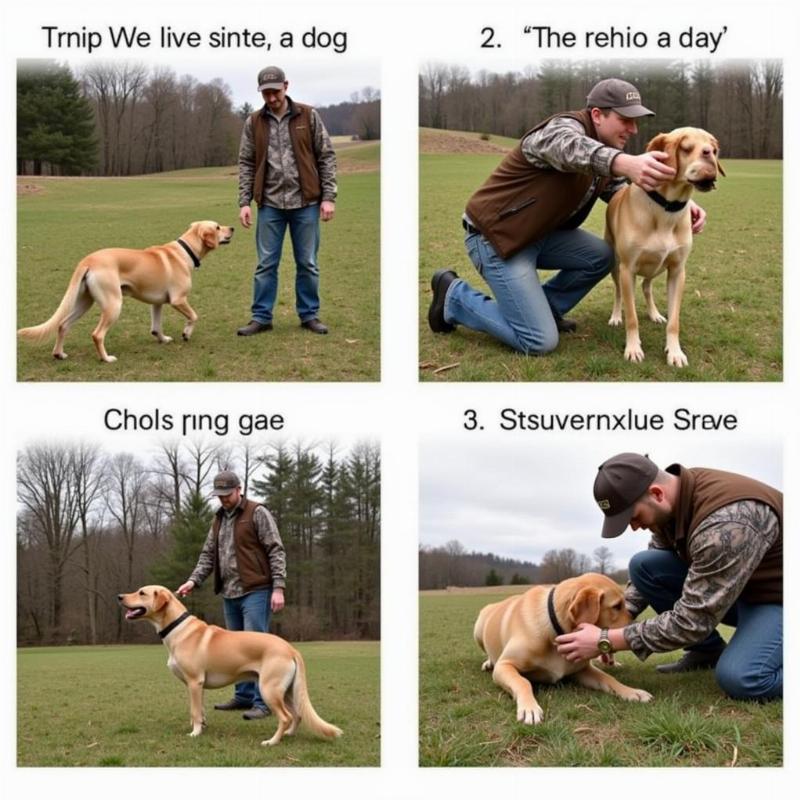Choosing the best hunting dog shock collar requires careful consideration. This guide helps you navigate the options available, focusing on responsible use and effective training for your hunting companion. We’ll explore the key features, training tips, and ethical considerations to ensure a safe and successful hunting experience for both you and your dog. [keyword] isn’t just about control, it’s about communication.
Understanding the Purpose of a Hunting Dog Shock Collar
A shock collar, more accurately termed an e-collar, is a training tool designed to communicate with your dog at a distance. For hunting dogs, this can be invaluable in reinforcing commands, correcting unwanted behaviors, and ensuring their safety in challenging environments. While the term “shock” may sound harsh, modern e-collars offer a range of stimulation levels, from a mild vibration to a stronger static pulse. The goal is to find the lowest effective level for your dog, prioritizing positive reinforcement and clear communication. Are you looking for better control over your hunting dog in the field? Then understanding the nuances of e-collar training is essential.
Key Features to Look for in a Hunting Dog Shock Collar
When selecting an e-collar, consider your dog’s breed, size, temperament, and the specific hunting environment. Range, stimulation levels, and waterproof capabilities are crucial factors. Look for collars with multiple training modes, including vibration and tone, allowing you to customize the stimulation to your dog’s needs. Durable construction and a long-lasting battery are essential for extended hunting trips. What features are most important for your hunting needs and your dog’s personality?
Range and Signal Reliability
A reliable signal over long distances is vital for controlling your dog in varied terrains. Choose a collar with a range appropriate for your hunting style. Are you hunting in dense woods or open fields? This will determine the necessary range.
Stimulation Levels and Customization
Multiple stimulation levels allow you to tailor the correction to your dog’s sensitivity and the specific situation. Start with the lowest setting and gradually increase only if necessary.
Waterproof and Durable Design
Hunting often involves exposure to water and harsh conditions. A waterproof and rugged collar is a must. Will your dog be retrieving waterfowl or navigating through thick brush? A durable collar is essential.
Responsible E-Collar Training Techniques
E-collar training should always be paired with positive reinforcement methods. Start with basic obedience commands and gradually introduce the e-collar as a reinforcement tool. Consistency and patience are key. Never use the collar to punish or intimidate your dog. How can you ensure your training methods are ethical and effective?
 Training a Hunting Dog with an E-Collar
Training a Hunting Dog with an E-Collar
Starting with Basic Obedience
A solid foundation in basic obedience is crucial before introducing an e-collar. Ensure your dog understands commands like “come,” “sit,” and “stay” before incorporating the collar.
Gradual Introduction and Positive Reinforcement
Introduce the e-collar gradually, pairing it with positive reinforcement like praise and treats. This helps your dog associate the collar with positive experiences.
Consistency and Patience
Consistent training and patience are crucial for successful e-collar training. Avoid over-correcting or using the collar inconsistently.
shock collars for hunting dogs
Ethical Considerations and Avoiding Misuse
E-collars are powerful tools and should be used responsibly. Misuse can lead to fear, anxiety, and even physical harm. Consult with a professional dog trainer experienced in e-collar training for personalized guidance. Are you committed to using the e-collar ethically and humanely?
shock collar for dogs that bark
Conclusion
Choosing the best hunting dog shock collar is a significant decision. Prioritize features that align with your hunting needs and your dog’s individual characteristics. Remember, responsible training and ethical use are paramount for ensuring a safe and successful hunting experience. By focusing on positive reinforcement and clear communication, you can build a stronger bond with your hunting companion and enhance your time in the field. What type of training will you implement to maximize your hunting dog’s potential?
FAQ
- Are shock collars cruel? When used responsibly and humanely, e-collars are not inherently cruel. Misuse can lead to negative consequences.
- What is the best age to start e-collar training? Consult with a professional trainer to determine the appropriate age based on your dog’s breed and maturity level.
- How do I choose the right stimulation level? Start with the lowest setting and gradually increase only if necessary. Observe your dog’s reaction carefully.
- Can I use an e-collar for all breeds of hunting dogs? Yes, but the specific collar and training approach may need to be adjusted based on the breed’s temperament and sensitivity.
- Are there any legal restrictions on using e-collars for hunting dogs? Regulations vary by location. Check your local laws and hunting regulations.
- How do I maintain my e-collar? Follow the manufacturer’s instructions for cleaning and maintaining the collar to ensure optimal performance and longevity.
- What should I do if my dog shows signs of distress during e-collar training? Immediately discontinue use and consult with a professional dog trainer.
best e collars for dog training
Beautdogs.us is your trusted resource for expert advice on dog breeds, care, and products. We offer comprehensive guides and reviews to help you make informed decisions for your canine companion. Whether you’re a seasoned dog owner or just starting out, Beautdogs.us provides valuable insights into all aspects of dog ownership. Contact us today for personalized advice! Email: [email protected], Phone: +1 501-555-7529.